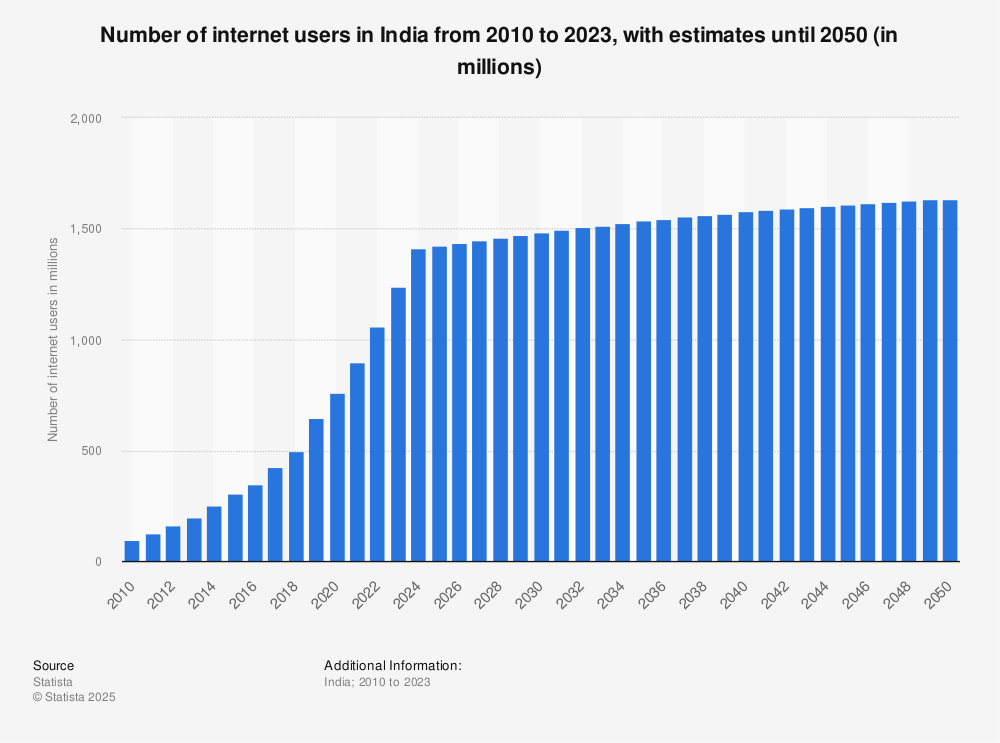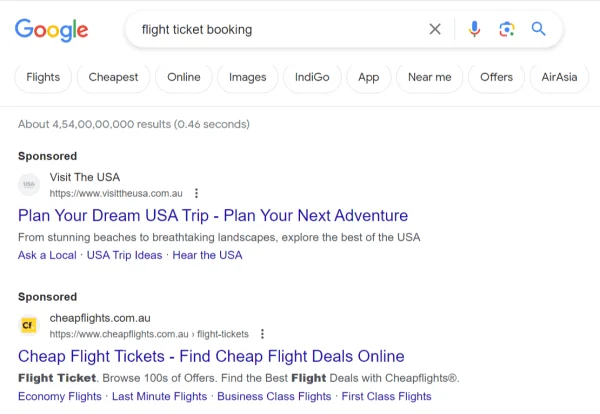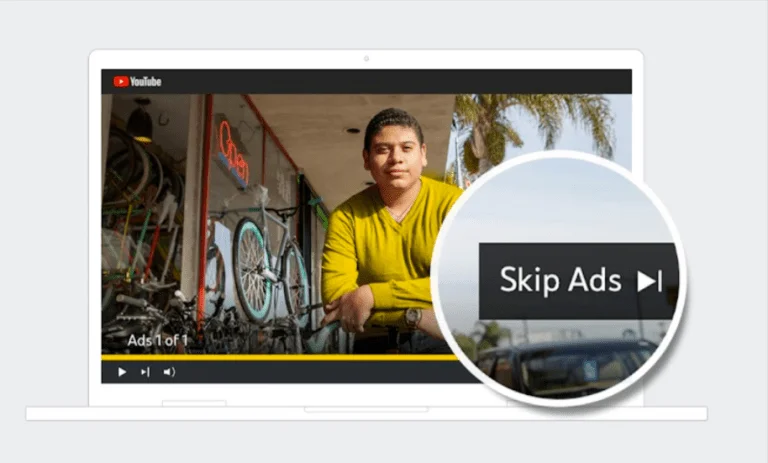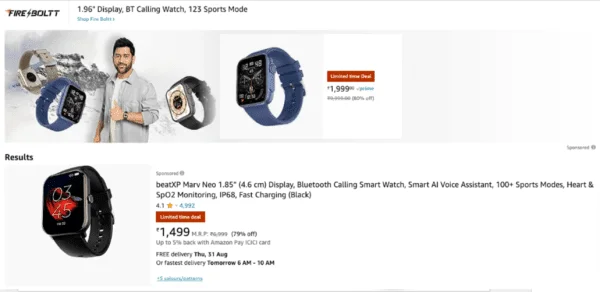Contents
- 1 Which Paid Marketing Channel is Right for your Business?
- 1.0.1 How to find the right audience based on business or goal?
- 1.0.2 Products
- 1.0.3 Services
- 1.0.4 What’s the Purpose or Goal?
- 1.0.5 Engagement
- 1.0.6 Traffic
- 1.0.7 Awareness
- 1.0.8 Leads
- 1.0.9 Sales
- 1.0.10 Which Channels your Competitors are using
- 1.0.11 Research
- 1.0.12 Social Media
- 1.0.13 Keywords
- 1.0.14 Content Sharing
- 1.0.15 Paid Advertising
- 1.0.16 Email Marketing
- 1.0.17 Top 6 Effective Paid Marketing Channels to Boost Sales or Leads
- 1.0.18 Search Ads
- 1.0.19 Example of Search Ads
- 1.0.20 Social Media Ads
- 1.0.21 Example of Facebook Ads
- 1.0.22 Display Ads
- 1.0.23 Example of Display Ads
- 1.0.24 YouTube Ads
- 1.0.25 Example of YouTube Ads
- 1.0.26 Marketplace Ads
- 1.0.27 Marketplace Ads Example
- 1.0.28 Conclusion:
Which Paid Marketing Channel is Right for your Business?
- Hemang Rami
- September 13, 2023
Are you a business owner looking to use paid marketing channels to promote your business but feeling confused about which one to use? In today’s digital world, there are many choices, and it can be a bit overwhelming. But don’t worry; we’re here to help you figure it out. This guide will walk you through the process of picking the right paid channel for your business in simple terms, making sure it matches your goals and connects with your potential customers.
In our digital age, using the internet to promote your business is a must. Did you know in India alone, over 624 million people use the internet? That’s a huge audience waiting to hear about your products or services!

These numbers highlight the vast reach of various marketing channels and how it can be tailored as per different business needs. By choosing the right channel, you can quickly tap into this vast online audience and grow your business effectively.
How to find the right audience based on business or goal?
Understanding whether you are in the business of selling products or services, the first step is to find the right audience. It lays the foundation for further refining your target audience based on factors like demographics, interests, and behaviours.
Products
If your business primarily sells products, consider factors such as the type of products you offer, their quality, price range, and uniqueness. For instance, if you sell high-end fashion accessories, your target audience might include individuals with a taste for luxury and a willingness to invest in quality. On the other hand, if you offer affordable everyday items, your audience might be more budget-conscious consumers.
Services
If your business provides services, your target audience is likely to be influenced by the nature of these services. For example, if you offer digital marketing services, your audience might include other businesses looking to improve their online presence. Identifying the specific services you provide, their benefits, and how they solve problems for your clients is crucial in narrowing down your audience.
What’s the Purpose or Goal?
Clearly defining your goal before launching the campaigns is very important for any one who is planning to start paid ads as it guides you to choose right paid advertising platforms, budget allocation, ad creatives, and targeting. Without a clear goal, you risk wasting your budget on campaigns that lack focus and direction.
So, before embarking on your paid ads journey, pinpoint your objective: engagement, traffic, awareness, leads, or sales. It’s the cornerstone of a successful paid marketing campaign. Here, we have break down the primary goals.
Engagement
If your aim is to boost engagement, you’ll be looking to create ads and content that resonate with your audience, encouraging likes, shares, and comments.
Traffic
When traffic is the goal, your strategy will focus on driving visitors to your website or landing pages through paid search or display advertising.
Awareness
For brand awareness, paid marketing helps ensure your brand is visible to a broader audience through display and social media advertising
Leads
If generating leads is the objective, you’ll set up campaigns with the aim of capturing potential customers’ information, often through lead forms or gated content.
Sales
Lastly, if sales are your primary goal, paid campaigns will be designed to drive conversions, whether it’s e-commerce sales or lead nurturing for a sales funnel.
Which Channels your Competitors are using
Understanding which paid marketing channels your competitors are using is a crucial aspect of any successful marketing strategy. In the ever-evolving digital landscape, staying competitive means knowing where your rivals are investing their marketing efforts. Here is how you can identify competitor channels.
Research
Start by researching your competitors. Visit their websites, social media profiles, and any online platforms where they have a presence.
Social Media
Examine their social media accounts. Which platforms are they most active on, and where do they have the largest following? Take note of the type of content they post and how often. For a deeper look into your competitors’ Facebook advertising strategies, you can utilize Facebook Ads Library which is Facebook’s own tool. This tool allows you to see the ads your competition is running, providing insights into their messaging and targeting strategies.
Keywords
Use tools like SEMrush or Ahrefs to identify the keywords your competitors are targeting. This can provide insights into their SEO and content marketing strategies. Once you’ve identified keywords that are relevant you can use Google Ads Keyword Planner to get an estimate of traffic and possible leads or sales that these keywords can deliver.
Content Sharing
Look for the content your competitors are creating and sharing. Are they primarily using blogs, videos, infographics, or other formats?
Paid Advertising
Monitor their paid advertising efforts. This includes pay-per-click (PPC) ads on search engines and social media platforms. To gain further insights into your competitors’ paid advertising efforts, consider using PPC competitor research tools like SpyFu. These tools can help you monitor your competitors’ pay-per-click (PPC) ads on search engines and social media platforms
Email Marketing
If possible, subscribe to their email newsletters to see what kind of content and offers they’re sending to their subscribers.
By thoroughly researching your competitors’ paid marketing channels, you can gain a clearer picture of the competitive landscape and make informed decisions about where to focus your own marketing efforts.
Top 6 Effective Paid Marketing Channels to Boost Sales or Leads
Search Ads
These campaigns are ideal for selling products and services that are already in high demand. When people are actively searching for what you offer, appearing at the top of search results is crucial.
These ads can be utilized to achieve various goals, including generating sales, leads, website traffic, and even driving potential customers to your physical store. They are particularly effective for reaching a high-intent audience, as searchers are actively seeking solutions or information related to your offerings.
Example of Search Ads

Social Media Ads
Social media ads includes ads on social platforms like Facebook, Instagram, and LinkedIn. They are known for their flexibility, allowing you to tailor campaigns to target very specific audiences based on interests and demographics.
High-quality visuals and compelling content are essential for these ads, as they tend to deliver better return on investment (ROI). Social media ads can be used effectively to achieve various objectives, including generating sales, capturing leads, driving store visits, promoting events etc. Their ability to reach and engage with a wide range of audiences makes them a versatile choice for many businesses.
Example of Facebook Ads

Display Ads
Google holds a dominant position in the space of display advertising due to its large network of websites that use Google’s Ads program for monetization. As a result, Google Display is the best channel for businesses seeking increased visibility.
However, it’s worth noting that social media platforms such as Facebook, Instagram, YouTube, and LinkedIn are also valuable options, particularly when the primary goal is to capture the attention of a broad audience. Display channels are typically used when the focus is on achieving softer goals like video views, impressions, expanding reach, and driving website traffic.
Example of Display Ads

YouTube Ads
YouTube is a powerful platform for showing video ads. It’s great for making people remember your brand or get to know it better. You can use it to share short, impactful messages, like movie trailers, upcoming sales, or new product launches.
But YouTube isn’t just for big brands. If you have interesting videos, it can help you sell more and find new customers too. It’s like talking to people who are already interested in what you offer.
Plus, YouTube is awesome for showing ads to people who’ve visited your website before. If lots of people have checked out your website, YouTube can help you reach them again. It’s a bit like reminding them about your brand. So, YouTube isn’t just about getting famous; it can help you make more sales and find new customers.
Example of YouTube Ads

Marketplace Ads
These ads are exclusively for folks who sell products on Amazon and Flipkart online marketplaces. They’re a must if you want to stand out in a crowded marketplace. But here’s the key: Before you dive into running these ads, make sure your product listings are in tip-top shape. That means to add your product titles, descriptions, images, and offering attractive discounts and A+ content, if possible.
Marketplace ads are super targeted and can deliver excellent returns on your investment. They’re all about making your products shine in the marketplace, so if you’re in the e-commerce game, these campaigns can be highly profitable for your business.
Marketplace Ads Example

Conclusion:
In the vast digital realm, making the right choices is key. This guide has shown you how to pick the best paid marketing options that suit your goals and your audience. With 624 million internet users in India, there’s enormous potential. By using the right methods, you can grow your business effectively.
Each paid marketing channel has its own strengths. For example, search ads are precise, while social media and display ads catch the eye. YouTube and marketplace ads engage your audience. Always choose what matches your business goals and your audience’s preferences. So, as you venture into paid ads campaigns, use these tools to tell your brand’s story, connect with customers, and find success online.
Ready to start your paid campaign for your business? Let’s discuss your requirement and start improving your business today.
